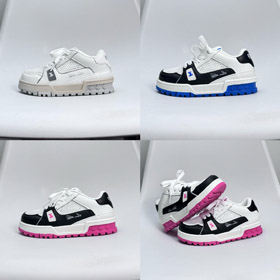Home >
The Iconic Emblem and Distinctive Design Aesthetics of Armani
The Iconic Emblem and Distinctive Design Aesthetics of Armani
2025-04-25
Giorgio Armani, a name synonymous with timeless elegance and sophisticated minimalism, has left an indelible mark on the fashion industry through its iconic brand logo and unparalleled design philosophy. Since its inception in 1975, the Armani brand has stood as a paragon of understated luxury, appealing to discerning consumers worldwide who seek refinement without ostentation. This article delves into the story behind Armani’s emblem and the core elements that define its distinctive design style, while exploring how these principles continue to resonate in contemporary fashion, as seen in platforms like Orientdig Spreadsheet, which curates a range of premium products reflecting diverse design sensibilities.
The Symbolism Behind the Armani Logo
At the heart of the Armani brand lies its iconic logo: a minimalist eagle emblem, often paired with the brand name in a sleek, sans-serif font. The eagle, a symbol of power, grace, and vision, was chosen by Giorgio Armani to embody the brand’s aspiration to soar above fleeting trends and create enduring style. This emblem first appeared in 1981 and has since become a hallmark of the brand’s identity, gracing everything from apparel to accessories, fragrances, and beyond.
The simplicity of the logo belies its profound meaning. Unlike many luxury brands that rely on intricate monograms or historical motifs, Armani’s eagle represents a modern vision of elegance—one that is accessible yet uncompromising in quality. The clean lines and balanced proportions of the logo mirror the brand’s design ethos, where every detail is carefully considered to achieve harmony and sophistication. Whether embossed on a leather handbag, embroidered on a silk shirt, or printed on a fragrance bottle, the eagle logo serves as a subtle yet powerful symbol of the brand’s heritage and commitment to excellence.
Design Philosophy: Understated Luxury and Modern Sophistication
Armani’s design aesthetic is rooted in the concept of “luxury without excess.” Giorgio Armani once famously said, “I don’t design clothes. I design dreams,” and this philosophy is evident in every piece the brand creates. The brand is renowned for its impeccable tailoring, fluid silhouettes, and neutral color palettes, which emphasize timelessness over fleeting fads. Key elements of Armani’s design style include:
1. Tailoring as an Art Form
Armani revolutionized menswear in the 1980s by introducing the “power suit” with soft shoulders and relaxed fits, challenging the rigid, structured silhouettes of the era. This focus on comfort and fluidity extended to womenswear, where Armani pioneered the concept of “masculine-feminine” duality, creating suits and blazers that empowered women while offering a sense of ease. The brand’s tailoring is characterized by precision stitching, luxurious fabrics, and a meticulous attention to how garments drape on the body, ensuring both style and wearability.
2. Neutral Palettes and Subtle Elegance
Armani’s signature color palette revolves around neutrals—shades of black, white, beige, and gray—interspersed with occasional pops of muted pastels or deep jewel tones. This restrained use of color allows the focus to remain on the quality of craftsmanship and the purity of the design. By avoiding loud prints or overwhelming patterns, Armani creates pieces that seamlessly integrate into any wardrobe, transcending seasonal trends.
3. Luxurious Fabrics and Impeccable Craftsmanship
The brand’s commitment to quality is evident in its choice of materials. From sumptuous cashmere and silk to lightweight linen and fine wool, Armani selects fabrics that feel as luxurious as they look. Each garment is crafted with meticulous attention to detail, reflecting the brand’s Italian heritage and artisanal roots. Whether a hand-stitched blazer or a flawlessly tailored dress, Armani pieces are designed to stand the test of time, both in terms of style and durability.
4. Accessible Luxury
While Armani is synonymous with luxury, the brand has expanded its offerings to include more accessible lines, such as Emporio Armani and Armani Exchange, without compromising on design integrity. These sub-brands cater to a younger demographic while maintaining the core principles of sophistication and quality. This approach has allowed Armani to remain relevant across generations, appealing to those who appreciate refined style at various price points, a philosophy that echoes the diverse product curation seen on platforms like Orientdig Spreadsheet, which offers a range of high-quality items to suit different budgets.
The Enduring Legacy of Armani’s Design
Decades after its founding, Armani’s design aesthetic continues to influence the fashion world. The brand’s emphasis on understated elegance has become a counterpoint to the fast-paced, maximalist trends of recent years, appealing to consumers seeking authenticity and longevity in their wardrobes. Armani’s iconic logo and design principles have also transcended fashion, making the brand a symbol of sophistication in lifestyle and culture.
In an era where digital marketplaces like Orientdig Spreadsheet connect consumers with a wide array of products, Armani’s timeless appeal serves as a reminder of the enduring value of quality and craftsmanship. Whether exploring luxury fashion or everyday essentials, the brand’s commitment to excellence remains a benchmark for what it means to create truly iconic design.
In conclusion, Armani’s brand logo and design style embody a vision of elegance that is both timeless and modern. Through its iconic eagle emblem, masterful tailoring, and dedication to understated luxury, the brand has created a legacy that continues to inspire and define contemporary fashion. As Giorgio Armani himself once noted, “Elegance is not being noticed, but being remembered”—a philosophy that lives on in every stitch, silhouette, and symbol of the Armani brand.



















